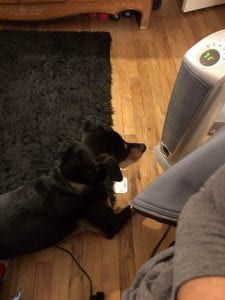The creative diversity built into the very foundations of social media technology affords participants and users of all backgrounds and intentions to create a networked space, an extension of themselves. Danah Michele Boyd extends the concept of “bedroom culture” to our creation of identity on social media platforms and profile creation. Her chapter on “Writing Oneself into Being” intrigued me, as it appealed to all types of users and groupings.
She writes about the various uses and displays of MySpace that teens employed to give their imagined audiences their desired portrayal of themselves. All of the featured adolescents rigidly adhered their profiles to a specific intention. Some wanted to follow the trends of the “in-group” popular students by posting content relevant to those groups and updating frequently. Others really only used it for its practical, communicative affordance to chat with their friends. Some used it to document their interests or as a creative outlet/platform. Regardless of what stance their profiles took, they all had an intended purpose, an imagined audience, and a set of restrictions and freedoms that worked in those contexts.
What fascinated me most about reading this article was the quick associations I was able to make from one group to the other. Very quickly, examples of each of these types of behaviors popped into my head alerting me to people I know and how they use social media, and how I do as well. I found myself rolling my eyes in some parts and agreeing with others, simply because even I was unconsciously searching for my place – my “in-group” – in the practices of identity creation through social media. It was a very trippy experience sending me back to high school, where dare I say – I perfectly parroted what Cara, the sarcastic 20-year-old who eschewed the identity practices of the “popular people” lamented:
“No expression is ever accurate enough to encompass all my human complexities…God forbid other people think I was faking myself or degrading the sum of my substance down to a list of my favorite movies and a few choice photos” (142).
And then I realized I was taking myself too seriously and had to slow down, return to my nice quarantine bedroom, smell the roses I have on my desk – and in my Instagram photos – pet my dog – who is also featured on my IG – and relax. Because the pressure to create a digitized version of yourself exists, yet, it is still a place to create an extension of yourself as freely as you wish.
One of the reasons why I was so intrigued by Boyd’s connection of identity creation on social networking platforms to “bedroom culture.” She claims that “Teens may show off their bedrooms off to friends, but they rarely have the opportunity to invite their entire cohort over to see their decorations” (138). As such, networked publics can be considered “virtual bedrooms” where “digital self-representations are equivalent to the bedroom walls” (138) and the decorations included.
After reading this, I realized I had roses everywhere in my room, and only at that moment did I realize I posted them semi-regularly on my IG as well. My pup is precious, and he’s on my IG everywhere. Yet, Boyd also disclaims “the difference between bedroom walls and profiles is the scale of the audience” (138). There is a restrictive element of virtual profiles beheld in the nature of the imagined audience and what it is perceived that they want and don’t want to see.
At first, this sounded ridiculous to me…and then I had that great lightbulb realization of that’s the very reason why I have never posted anything even referencing my love of makeup and makeup artistry. It’s out of left field, nothing I’ve ever done before, so why would any of my less than one hundred followers want to see it? The answer is: they wouldn’t care.
This all goes to show that there is such a strong psycho-sociological element to not just maintaining and using networked publics, but to writing yourself into being.
I think these concepts of writing ourselves into being and creating fragmented dissociations of our identity strongly tie into our interactions with memes, their contexts, and the overlaying culture bracketing it all.
I’ve read through just about everyone else’s blogs in this module because it is such a diverse and unique topic, and I was fascinated to see a pattern of remark on how the general perception of memes are as something relatable, entertaining, and crafting of an inclusive community of shared sentiment.
Meme: units of popular culture that are circulated, imitated, and transformed by internet users, creating a shared cultural experience
To share a small personal case study of my experience with memes, I follow numerous meme-specific accounts. The ones most prominent in my mind are Bestmemes and a plethora of baby Yoda memes. To say baby Yoda has taken over the meme community as of late would be an understatement, and I am curious how these memes connect to those highly valenced socio-political memes discussed by Milner and Spenser.
The aesthetics of “cute” displayed in the baby Yoda memes closely resembles the aesthetic of the animal lovers’ communities on Instagram. The appearance of “dog speak” and the worship of “fur babies” in these public networks has created a lovable, yet intensely odd, community of lovers of all things cute and animal-like.
This aesthetic of cute has even transcended pet communities and has been transposed onto the #couples niche of Instagram. There has been an outcropping of memes employing “cute” features, such as sad puppy eyes and baby language to reference the girlfriends in a relationship. Some examples of that using the baby yoda templates:
I think this definitely ties into an aspect of the gender argument Milner is making. While women are not objectified and sexualized in these memes, the contexts surrounding them instead render women to be unintelligent – due to the “baby talk” – and childlike. While these images can be perceived as innocuous and cute to those in a relationship (and I cringe to say that, yes, these memes were taken directly out of a chat with my partner and me), to look at the larger circuit of consumers of these memes, they can certainly be construed as marginalizing to women.
So, while there certainly is an element of relating to memes, there are contexts and tones that highly charge the trajectory and social contexts of these memes when they are critically analyzed with those lenses. Milner did an excellent job of mapping out the creation of a meme to deliver its punchline through the format and template of the meme. He claims that memes are “easily read” for their “content and form,” which can be seen in the image below:

Macro humour derives from incongruity (the class between expectation and experience) – setting up joke at the top of the image, visual ellipses/pause between joke and punch line (readers associate it with a prior context), punch line at the bottom of the image (paraphrased from Milner)
However, as Milner writes of memes, they are “aesthetic manifestations of lulz” and trolling culture. They aren’t simply a means of laying out a digital joke, but a joke at the expense of another participant or audience. The “stance” of a meme “has more subtle dimensions. Tone and intent are hard to read” in contrast to the ease of reading content and form. Thus, when considering a meme for its relatability, as we subconsciously do, there is an added element of analyzing who it might be trolling as well. What can appear innocently cute or harmlessly funny, can in fact be marginalizing an excluded audience, undermining a social issue, or even sarcastically joking to undermine the participants in malignant stereotypes.

Food for thought: How is this radically different than other Sheldon Copper sarcasm memes? There are multiple valences here…
At the end of the day, memes can be incredibly ambiguous, especially when they relate so much to the logic of lulz. A meme is not just content and form, but stance and context. There were numerous times when I was sent a meme and didn’t respond because I simply didn’t understand the contexts surrounding them like my friends did. Sometimes there’s a mediation necessary to properly understand the stances and contexts of these posts. The valences of memes can be so subtly, ironic, sarcastic, or plain crude. Yet, how we choose to traverse the ambiguities of memes and the logic of lulz in meme culture and networked publics is determined by our own identity crafting and participation in said networked public.
“Irony markers can be employed ceaselessly to a multitude of ends,” but how we choose to tackle and respond to those irony markers, whether by ignoring, reporting, commenting, liking, bookmarking, sharing, or reposting, lies in our own personal and critical balances and approaches to our participation in these networks. How we decide to shape our identity and participation in a social network really demonstrates our navigation of these antagonistic/agonistic valences to digital culture, I think, and can create a gateway to how we can incorporate a more critical approach to such a personal, yet publicized, extension of ourselves.
This concept of identity extension and deliberate formation into a digital sphere is so fascinating to me because you are given a forum to dump however much or little of your identity there that you want. Yet, there’s still a dissociative element from the physical body, which I am eager to explore more in my undertaking of Module 3: Bodies, Interrupted for next time.
A final thought is one that has lingered in my mind for some odd years now, but I never felt the opportune moment to put it into words (thanks quarantine writing dump): No matter how hard we try, no other person will perceive us the exact same way we perceive ourselves in our entire life. So, how does that factor into how we then receptively present ourselves?
~~
I definitely took an unconventional route with this blog. I was so fascinated by the idea of “writing yourself into being” in networked publics that I felt I had to speak to it; yet, I had so many critical thoughts on memes and the logic of lulz that there was no way I could fit it all. So I tried to explore what I could in a way that made sense, and if you followed me through this haziness, thank you! I will reward with photos of my own “fur baby” – sorry I have no cats to share!











The last thing I saw was the doggy, which was very, very cute! Thanks. He’s a little button with a lot of personality!
I quite like your reflections on this unit, especially writing yourself into being. Most of us don’t have viral followings on social media, and some will never have much of a following at all. Does that mean only people who know how to work virtual audiences should use social media? I don’t think so. I think for many, social media is productive at constructing a positive self (or self-image anyway). Some of my best tweets, the ones that I am personally proud of, might have gotten one or two likes, while the few that blew up sometimes I did not even care about. I’d sit back and say why do people like this? And given my profession, I should know my audience pretty well. But social media audiences are really harder to parse than audiences in the past. That being said, some people (especially, I think, young people) are very skilled at parsing their online audiences. When they are not, it can have disastrous results because they don’t have stable identities and can be psychologically injured by unforeseen consequences. Rather than attending so vigilantly to their online audiences, they perhaps ought to be writing themselves into being within a trusted smaller group. Perhaps at one time, tumblr and certain kinds of fandoms were those kind of spaces, although I’m not sure how true that is anymore. Also, an immature person who is skilled within one audience online can be blindsided easily when they venture into a different audience and don’t understand the rhetorical situation (although many have the skill, through nature or practice, to discern rhetorical situation).
I’m very interested in your take on memes and context, and have something you could think about: the way reading memes in a community of those who “understand” the meme writes our self into being. That little jolt of pleasure or kick that we feel when we encounter a meme that we “get.” Every time we experience that, are we more and more revealing to ourselves who we are, perhaps in a community of like-minded others? If we are turned off by a meme, we are also writing ourselves into being by negation. I really like this: “Yet, how we choose to traverse the ambiguities of memes and the logic of lulz in meme culture and networked publics is determined by our own identity crafting and participation in said networked public.”